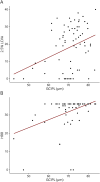Retinal Damage and Visual Network Reconfiguration Defines Visual Function Recovery in Optic Neuritis
- PMID: 39213469
- PMCID: PMC11368233
- DOI: 10.1212/NXI.0000000000200288
Retinal Damage and Visual Network Reconfiguration Defines Visual Function Recovery in Optic Neuritis
Abstract
Background and objectives: Recovery of vision after acute optic neuritis (AON) is critical to improving the quality of life of people with demyelinating diseases. The objective of the study was to prospectively assess the changes in visual acuity, retinal layer thickness, and cortical visual network in patients with AON to identify the predictors of permanent visual disability.
Methods: We studied a prospective cohort of 88 consecutive patients with AON with 6-month follow-up using high and low-contrast (2.5%) visual acuity, color vision, retinal thickness from optical coherence tomography, latencies and amplitudes of multifocal visual evoked potentials, mean deviation of visual fields, and diffusion-based structural (n = 53) and functional (n = 19) brain MRI to analyze the cortical visual network. The primary outcome was 2.5% low-contrast vision, and data were analyzed with mixed-effects and multivariate regression models.
Results: We found that after 6 months, low-contrast vision and quality of vision remained moderately impaired. The thickness of the ganglion cell layer at baseline was a predictor of low-contrast vision 6 months later (ß = 0.49 [CI 0.11-0.88], p = 0.012). The structural cortical visual network at baseline predicted low-contrast vision, the best predictors being the betweenness of the right parahippocampal cortex (ß = -036 [CI -0.66 to 0.06], p = 0.021), the node strength of the right V3 (ß = 1.72 [CI 0.29-3.15], p = 0.02), and the clustering coefficient of the left intraparietal sulcus (ß = 57.8 [CI 12.3-103.4], p = 0.015). The functional cortical visual network at baseline also predicted low-contrast vision, the best predictors being the betweenness of the left ventral occipital cortex (ß = 8.6 [CI: 4.03-13.3], p = 0.009), the node strength of the right intraparietal sulcus (ß = -2.79 [CI: -5.1-0.4], p = 0.03), and the clustering coefficient of the left superior parietal lobule (ß = 501.5 [CI 50.8-952.2], p = 0.03).
Discussion: The assessment of the visual pathway at baseline predicts permanent vision disability after AON, indicating that damage is produced early after disease onset and that it can be used for defining vision impairment and guiding therapy.
Conflict of interest statement
P. Villoslada has received consultancy fees and holds stocks in Bionure Investment, Accure Therapeutics, Attune Neurosciences, QMENTA, CLight, NeuroPrex, Spiral Therapeutics, and Adhera Health, none related to this study. P. Villoslada holds patent rights and has received royalties and consultancy fees from Oculis Holding AG for using OCS-05 (aka BN201) to treat optic neuritis (NCT04762017). S. Llufriu received compensation for consulting services and speaker honoraria from Biogen Idec, Novartis, Janssen, Merck and Bristol-Myers Squibb, and holds grants from the Instituto de Salud Carlos III. Go to
Figures




References
MeSH terms
LinkOut - more resources
Full Text Sources
